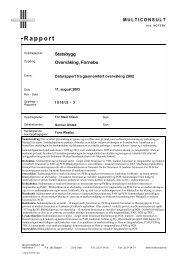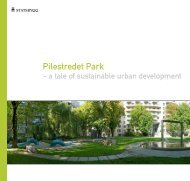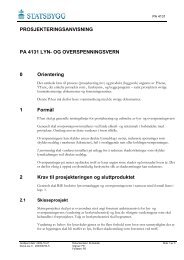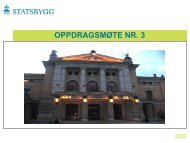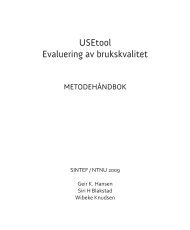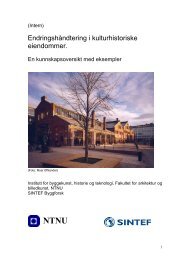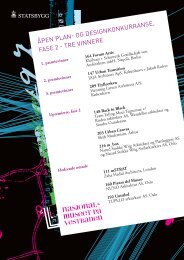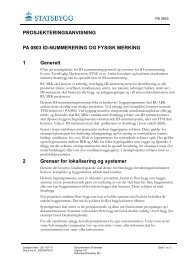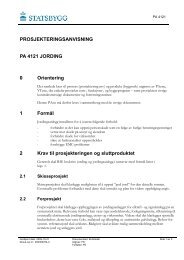Triazoles in the terrestrial environment - Statsbygg
Triazoles in the terrestrial environment - Statsbygg
Triazoles in the terrestrial environment - Statsbygg
Create successful ePaper yourself
Turn your PDF publications into a flip-book with our unique Google optimized e-Paper software.
NGI report no. 20001103-128 February 2002aquateam
<strong>Triazoles</strong> <strong>in</strong> <strong>the</strong> <strong>terrestrial</strong><strong>environment</strong>F<strong>in</strong>al report20001103-1 28 February 2002Client:Contact person:Contract reference:Oslo Ma<strong>in</strong> Airport (OSL)<strong>Statsbygg</strong> (SB)Norwegian Airforce (LFK)Jarl Øvstedal (OSL)Tone Westby (SB)Gerda Grøndahl (LFK)For <strong>the</strong> Norwegian Geotechnical InstituteProject Manager:Report prepared by:Reviewed by:Gijs D. BreedveldGijs D. BreedveldRoger Roseth (Jordforsk)Lars Hem (Aquateam)Magnus SparrevikAmy OenPostal address: P.O. Box 3930 Ullevaal Stadion, N-0806 OSLO, NORWAY Telephone: (+47) 22 02 30 00 Postal account: 0814 51 60643Street address: Sognsveien 72, OSLO Telefax: (+47) 22 23 04 48 Bank account: 5096 05 01281Internet: http://www.ngi.no e -mail: ngi@ngi.no Bus<strong>in</strong>ess No. 958 254 318 MVABS EN ISO 9001, Certified by BSI, Registration No. FS 32989
<strong>Triazoles</strong> <strong>in</strong> <strong>the</strong> <strong>terrestrial</strong> <strong>environment</strong> Report No.: 20001103-1Date: 2002-02-28Rev.:F<strong>in</strong>al reportRev. date:Page: 3SummaryTo guarantee safety and regularity of air traffic at airports located <strong>in</strong> coldclimates, large amounts of de-ic<strong>in</strong>g chemicals are used on runways andaircrafts prior to take-off. Propylene glycol (PG) is <strong>the</strong> ma<strong>in</strong> constituent used <strong>in</strong>deic<strong>in</strong>g fluids. Fur<strong>the</strong>rmore, additives are added to improve <strong>the</strong> properties ofdeic<strong>in</strong>g fluids with respect to viscosity (adhesiveness), corrosivity and<strong>in</strong>flammability. The <strong>environment</strong>al fate of many of <strong>the</strong> additives <strong>in</strong> <strong>the</strong> deic<strong>in</strong>gagents is poorly understood.Benzotriazole (BT), a corrosion and flame <strong>in</strong>hibitor, was detected <strong>in</strong> soil andgroundwater at <strong>the</strong> former Oslo Airport Fornebu two years after deic<strong>in</strong>gactivities ceased. BT was detected <strong>in</strong> <strong>the</strong> groundwater at <strong>the</strong> new Oslo AirportGardermoen already after <strong>the</strong> first deic<strong>in</strong>g season (1998-1999). Concentrationsare greatest early <strong>in</strong> <strong>the</strong> summer season after <strong>the</strong> spr<strong>in</strong>g snowmelt. No <strong>in</strong>crease<strong>in</strong> BT groundwater concentrations or off-site migrations have been detectedthus far, <strong>in</strong>clud<strong>in</strong>g <strong>the</strong> last measurements/samples taken <strong>in</strong> <strong>the</strong> summer of2001.Methyl substituted triazoles or tolytriazoles (MeBT) were found <strong>in</strong>concentrations less than 10 % of <strong>the</strong> BT concentration.BT showed very little sorption <strong>in</strong> <strong>the</strong> various soil matrices, only peat andcompost with a high organic carbon content exhibited significant sorption.Sorption could be best described us<strong>in</strong>g a Freundlich sorption iso<strong>the</strong>rm. Theseresults <strong>in</strong>dicate a high mobility of BT <strong>in</strong> soil and groundwater.No proof of microbial degradation of BT under aerobic or anaerobic conditionswas found us<strong>in</strong>g <strong>in</strong>oculumn from both Fornebu and Gardermoen. However,removal of BT was observed under aerobic conditions. This was attributed tovolatilisation, s<strong>in</strong>ce a similar loss was observed <strong>in</strong> <strong>the</strong> abiotic control.Microtox tests of <strong>the</strong> water samples from Fornebu revealed no acute toxicresponse, however a reduction <strong>in</strong> nitrification rate was observed. Thenitrification response could not be related directly to <strong>the</strong> BT concentration <strong>in</strong><strong>the</strong> samples, although samples with a high BT concentration showed <strong>the</strong> largestreduction <strong>in</strong> nitrification rate.BT can be degraded photochemically us<strong>in</strong>g UV irradiation. However highradiation doses are required and <strong>in</strong>termediate products form, which give anegative response <strong>in</strong> acute toxicity tests. Anil<strong>in</strong>e, Phenaz<strong>in</strong>e and an unknowncompound have been detected <strong>in</strong> treated water samples.The use of BT <strong>in</strong> many products and applications is widespread. Its mobilenature <strong>in</strong> <strong>the</strong> <strong>terrestrial</strong> ecosystem, <strong>the</strong> absence of microbial degradation and<strong>the</strong> toxicity of <strong>the</strong> compound has heightened <strong>the</strong> awareness of us<strong>in</strong>g <strong>the</strong>sechemicals <strong>in</strong> <strong>the</strong> <strong>environment</strong>. However, <strong>the</strong> absence of <strong>in</strong>formation on <strong>the</strong>long-term fate of BT warrants fur<strong>the</strong>r <strong>in</strong>vestigations on this group ofcompounds.F:\P\2000\11\20001103\Rap\BTf<strong>in</strong>alreport.docGBr/wut
<strong>Triazoles</strong> <strong>in</strong> <strong>the</strong> <strong>terrestrial</strong> <strong>environment</strong> Report No.: 20001103-1Date: 2002-02-28Rev.:F<strong>in</strong>al reportRev. date:Page: 4Contents1 INTRODUCTION.......................................................................................52 ENVIRONMENTAL DATA ON BENZOTRIAZOLE..............................63 OCCURENCE IN SOIL AND GROUNDWATER....................................73.1 Occurence at Fornebu ........................................................................73.2 Occurence at Gardermoen..................................................................94 SORPTION BEHAVIOUR .......................................................................115 DEGRADATION UNDER AEROBIC AND ANAEROBICCONDITIONS...........................................................................................126 TOXICITY OF TRIAZOLES FOR SOIL MICROORGANISMS. ..........137 PHOTO CHEMICAL DEGRADATION..................................................148 CONCLUSIONS AND RECOMMENDATIONS....................................169 DETAILED INFORMATION ..................................................................17REFERENCES ...................................................................................................18Review and reference documentF:\P\2000\11\20001103\Rap\BTf<strong>in</strong>alreport.docGBr/wut
<strong>Triazoles</strong> <strong>in</strong> <strong>the</strong> <strong>terrestrial</strong> <strong>environment</strong> Report No.: 20001103-1Date: 2002-02-28Rev.:F<strong>in</strong>al reportRev. date:Page: 51 INTRODUCTIONDeic<strong>in</strong>g chemicals are used at most airports operat<strong>in</strong>g <strong>in</strong> cold climates. Thesafety of air-transport necessitates that runways and aircrafts are kept free ofboth ice and snow. In order to ensure safe take-off and land<strong>in</strong>g, <strong>in</strong>dependent of<strong>the</strong> wea<strong>the</strong>r conditions, aircraft deic<strong>in</strong>g/antiic<strong>in</strong>g fluids (ADFs) and runwaydeic<strong>in</strong>g chemicals are often required. ADFs are pr<strong>in</strong>cipally based on propyleneglycol (PG) while runway deicers generally are based on potassium acetate,formate or urea. However, <strong>the</strong> use of PG or ethylene glycol (EG) based deicerson runways has also been reported (Corsi et al., 2001a).Dur<strong>in</strong>g a normal w<strong>in</strong>ter at a medium size <strong>in</strong>ternational airport, <strong>the</strong> estimatedneed for ADF can vary from 1000-10,000 tons depend<strong>in</strong>g on wea<strong>the</strong>rconditions and traffic density (Betts, 1999; Cornell et al., 2000). Most airportsthat use deic<strong>in</strong>g agents for aircrafts have established collection systems torecover concentrated spills. However approximately 20 % of ADFs arediffusively spread along <strong>the</strong> runways dur<strong>in</strong>g aircraft take-off and as a result ofsnow clear<strong>in</strong>g (OSL, 2001). Novak and co-workers (2000) report that morethan 60% of <strong>the</strong> applied ADFs was lost to <strong>the</strong> surround<strong>in</strong>g land at a Canadianairport. At Oslo Airport Gardermoen (OSL), a total amount of about 100,000m 3 of stormwater with a concentration range of 20-1600 mg/l PG are generatedeach year, most of which dur<strong>in</strong>g a short period of snowmelt (S. Moen, 2001,personal communication). At many airports this run-off <strong>in</strong>filtrates <strong>in</strong> <strong>the</strong> subsurface<strong>in</strong> an uncontrolled fashion result<strong>in</strong>g <strong>in</strong> pollution of ground and surfacewater bodies (Fisher et al., 1995; Corsi et al., 2001a and 2001b). Some airportshave tried to control this run-off and enhance <strong>the</strong> degradation of deicers <strong>in</strong> <strong>the</strong>soil adjacent to runways to prevent groundwater pollution (Roseth et al., 1998;Breedveld et al., 2001; Switzenbaum et al., 2001).ADFs are typically composed of 50-80 % PG and 20-50 % water. Additives (1-4 %) are used to improve <strong>the</strong> properties of ADFs with respect to viscosity(adhesiveness), corrosivity and <strong>in</strong>flammability (Novak et al., 2000). The exactcomposition of <strong>the</strong> additives may vary between products and is of a proprietarynature (referred to as AdPack). However triazoles <strong>in</strong> <strong>the</strong> form of benzotriazoles(BT) or methylbenzotriazoles (MeBT or tolyltriazole), are generally present toreduce <strong>the</strong> flammability hazard from corrosion of metal components carry<strong>in</strong>g adirect current (Cornell et al., 2000). The concentration of triazoles <strong>in</strong> undilutedADF has been reported to be approximately 0.05 % (Petersen et al., 1999),while Cornell and co-workers (2000) report values of 0.5 to 0.6 %.Propylene glycol is easily biodegradable and its impact on <strong>the</strong> soil andgroundwater is well documented (French et al., 2001; Shupack and Anderson,2000; Bakken and Swensen, 1998; Roseth et al., 1998). However, <strong>the</strong><strong>environment</strong>al fate and transport of <strong>the</strong> ADF additives is poorly understood.The detection of benzotriazole <strong>in</strong> <strong>the</strong> groundwater below <strong>the</strong> new Oslo Ma<strong>in</strong>airport at Gardermoen spr<strong>in</strong>g 1999 generated an immediate need forf:\p\2000\11\20001103\rap\btf<strong>in</strong>alreport.docGBr/wut
<strong>Triazoles</strong> <strong>in</strong> <strong>the</strong> <strong>terrestrial</strong> <strong>environment</strong> Report No.: 20001103-1Date: 2002-02-28Rev.:F<strong>in</strong>al reportRev. date:Page: 6<strong>environment</strong>al data on benzotriazoles. In order to fill <strong>in</strong> <strong>the</strong> gaps <strong>in</strong> <strong>the</strong>available data, Jordforsk, Aquateam and NGI <strong>in</strong>itiated an exploratory studydur<strong>in</strong>g 2000 and 2001. The study covered <strong>the</strong> follow<strong>in</strong>g topics:• The distribution of triazoles <strong>in</strong> soil and groundwater at <strong>the</strong> old Oslo AirportFornebu and <strong>the</strong> new Oslo Airport Gardermoen.• Sorption behaviour <strong>in</strong> various soil matrices.• Degradation <strong>in</strong> groundwater under aerobic and anaerobic conditions.• Toxicity of triazoles for soil microorganisms.Additional research <strong>in</strong> <strong>the</strong> field of photochemical degradation by UV-radiationwas <strong>in</strong>itiated to identify treatment options.This report provides an overview over <strong>the</strong> ma<strong>in</strong> f<strong>in</strong>d<strong>in</strong>gs of this study. Detailson experimental procedures and results are found <strong>in</strong> <strong>the</strong> separate reports oneach topic.2 ENVIRONMENTAL DATA ON BENZOTRIAZOLEApart from applications <strong>in</strong> aircraft deicers, benzotriazole and tolyltriazole arewidely used <strong>in</strong> cool<strong>in</strong>g fluids, hydraulic fluids, lubricants, polymer stabilizersand <strong>in</strong> <strong>the</strong> metal plat<strong>in</strong>g <strong>in</strong>dustry as brighten<strong>in</strong>g agents.BT is a weak organic acid (figure 1a) with a pK a of 8.6 (Andreozzi et al., 1998)and of a weak hydrophobic nature (log K ow = 1.44). Tolyltriazole is usuallyfound as a mixture of two isomers: 4-methylbenzotriazole and 5-methylbenzotriazole(figure 1b) with a pK a of 8.8 and a log K ow > 2 (Cornell et al., 2000).a6574HN123NNb65CH 374HN123NNFig. 1Chemical structures of benzotriazole (a) and tolyltriazole (b).Only limited ecotoxicological data are available, mostly from acute toxicitytests (table 1). A Chronic, 21 day reproduction toxicity tests us<strong>in</strong>g Daphniamagna resulted <strong>in</strong> a no observed effect concentration (NOEC) of 3 mg/l(Sverdrup and Fürst, 1999). Based on <strong>the</strong>se results a predicted no effectconcentration (PNEC) for BT of 0.06 mg/l was calculated (Hem et al., 2000).The compound is classified as “toxic to aquatic organisms and can causelongterm adversary effects <strong>in</strong> <strong>the</strong> aquatic <strong>environment</strong>.”f:\p\2000\11\20001103\rap\btf<strong>in</strong>alreport.docGBr/wut
<strong>Triazoles</strong> <strong>in</strong> <strong>the</strong> <strong>terrestrial</strong> <strong>environment</strong> Report No.: 20001103-1Date: 2002-02-28Rev.:F<strong>in</strong>al reportRev. date:Page: 7Table 1Summary of chemical and biological data on benzotriazole available<strong>in</strong> literature (Hem et al., 2000).Solubilityg/lBiodegradability20 NotdegradableLogK ow1.440-1.2BacteriaEC 50 mg/lAlgaeEC 50 mg/l>10041 69.9Toxicity dataPelagiccrustacean EC 50mg/lBenticcrustaceanLC 50 mg/kgFishLC 50 mg/l20122 504 130No evidence of microbial degradation of BT or MeBT has been published thusfar (Hem et al., 2000, Gruden et al., 2001). However, a gradual removal hasbeen observed <strong>in</strong> <strong>the</strong> presence of peroxidases from horseradish plants andwhite rot fungus Phanerochaete chrysosporium (Wu et al., 1998). Removalfrom <strong>the</strong> aqueous phase has also been observed <strong>in</strong> <strong>the</strong> presence of several o<strong>the</strong>rplants (Castro et al., 2001). However it is unclear whe<strong>the</strong>r this removal is aresult of evapotranspiration or transformation/degradation. Rapiddecomposition has been observed by <strong>the</strong> Fenton reaction and photochemicallyunder <strong>the</strong> <strong>in</strong>fluence of UV irradiation (Wu et al., 1998; Andreozzi et al., 1998).3 OCCURENCE IN SOIL AND GROUNDWATER3.1 Occurence at FornebuOslo’s former airport at Fornebu, which is located on a pen<strong>in</strong>sula <strong>in</strong> <strong>the</strong> Oslofjord, was closed <strong>in</strong> 1998 after 59 years of operation. Redevelopment of <strong>the</strong> sitefor hous<strong>in</strong>g and offices required remediation of contam<strong>in</strong>ated sites. The areasof major concern with respect to contam<strong>in</strong>ation by ADFs were <strong>the</strong> deic<strong>in</strong>g pad,<strong>the</strong> ADF regeneration plant, <strong>the</strong> snow disposal site as well as <strong>the</strong> stormwatercollection/run-off system, which dra<strong>in</strong>s towards <strong>the</strong> fjord (Figure 2). Samplesfrom surface soils, sediments, groundwater and dra<strong>in</strong>age water were collectedapproximately one and two years after airport deic<strong>in</strong>g operations ceased.Table 2BT levels <strong>in</strong> soil and sediment samples at Fornebu (mg/kg d.w.)Site Depth No. of Mean conc. M<strong>in</strong>. Max.(m) samplesRunways 0-0.1 20 0.33
<strong>Triazoles</strong> <strong>in</strong> <strong>the</strong> <strong>terrestrial</strong> <strong>environment</strong> Report No.: 20001103-1Date: 2002-02-28Rev.:F<strong>in</strong>al reportRev. date:Page: 8BT was detected <strong>in</strong> low concentrations (0.33 mg/kg d.w. average) <strong>in</strong> 19 of <strong>the</strong>20 soil samples taken from <strong>the</strong> topsoil along <strong>the</strong> runways (table 2). Elevatedconcentrations (0.66 mg/kg d.w.) were detected at <strong>the</strong> snow disposal site withno observed difference between <strong>the</strong> topsoil and 1 meter depth. High concentrationswere observed (13 mg/kg d.w.) <strong>in</strong> <strong>the</strong> organic bottom sediments of asmall ditch dra<strong>in</strong><strong>in</strong>g <strong>the</strong> snow disposal site. BT could also be detected <strong>in</strong> <strong>the</strong>upper organic layer of a wetland area receiv<strong>in</strong>g <strong>the</strong> dra<strong>in</strong>age water from <strong>the</strong>snow disposal site (0.42 mg/kg d.w.). No BT was detected below 0.1 m depth.In contrast to reports from Nor<strong>the</strong>rn America (Cancilla et al., 1998; Cornell etal., 2000), BT was <strong>the</strong> ma<strong>in</strong> triazole found at Fornebu, while MeBTs were onlydetected <strong>in</strong> trace amounts.Fig. 2 Overview over <strong>the</strong> former airport Fornebu and <strong>the</strong> sampl<strong>in</strong>g sites; A,runways; B, snowdisposal site; C, wetland; D, deic<strong>in</strong>g pad; E,regeneration plant.Groundwater and surface water samples were taken from <strong>the</strong> snow disposalsite, <strong>the</strong> dra<strong>in</strong>age ditch, <strong>the</strong> deic<strong>in</strong>g pad and <strong>the</strong> ADF regeneration plant. PGf:\p\2000\11\20001103\rap\btf<strong>in</strong>alreport.docGBr/wut
<strong>Triazoles</strong> <strong>in</strong> <strong>the</strong> <strong>terrestrial</strong> <strong>environment</strong> Report No.: 20001103-1Date: 2002-02-28Rev.:F<strong>in</strong>al reportRev. date:Page: 9could be detected <strong>in</strong> only one of <strong>the</strong> groundwater samples one year afterdeic<strong>in</strong>g activities ceased at Fornebu. BT was detected <strong>in</strong> all of <strong>the</strong> watersamples (table 3). Levels of tolyltriazoles were below 1 µg/l with <strong>the</strong> exceptionof one sample from <strong>the</strong> wetland area. The concentration levels varied 3 ordersof magnitude from 1.2 µg/l to 1100 µg/l even with<strong>in</strong> <strong>the</strong> same location. On <strong>the</strong>deic<strong>in</strong>g pad <strong>the</strong> concentration differences could be related to <strong>the</strong> soil matrixcomposition. High values were observed <strong>in</strong> groundwater from <strong>the</strong> sand andgravel deposits, which were used to backfill, <strong>the</strong> deic<strong>in</strong>g pad dur<strong>in</strong>g itsconstruction. Areas with <strong>the</strong> orig<strong>in</strong>al peat and clay deposits showed only lowlevels of BT <strong>in</strong> <strong>the</strong> groundwater. Groundwater samples were generallyanaerobic with high levels of DOC and a marked sulfidic odour (table 3).Table 3BT and PG levels <strong>in</strong> groundwater and surface water samples fromFornebuSite BT(µg/l)PG(mg/l)DOC(mg/l)Fe(mg/l)2-SO 4(mg/l)33 4 15.5 - -12 - - - -Snow disposal 8.9 - - - -1.6 - - - -2.7
<strong>Triazoles</strong> <strong>in</strong> <strong>the</strong> <strong>terrestrial</strong> <strong>environment</strong> Report No.: 20001103-1Date: 2002-02-28Rev.:F<strong>in</strong>al reportRev. date:Page: 10Deic<strong>in</strong>g pad ANDeic<strong>in</strong>g pad BNRunway WestRunway WestDeic<strong>in</strong>g pad ASFig. 3Overview over <strong>the</strong> Oslo airport Gardermoen and <strong>the</strong> sites whichwhere sampled; AN, AS, BN deic<strong>in</strong>g pads.Analysis of <strong>the</strong> data collected dur<strong>in</strong>g 1999 and 2000 reveal that highconcentrations of BT are observed <strong>in</strong> <strong>the</strong> storm-water system and groundwaterbelow <strong>the</strong> de-ic<strong>in</strong>g platform. Concentrations <strong>in</strong>crease dur<strong>in</strong>g w<strong>in</strong>tertime,reach<strong>in</strong>g a peak <strong>in</strong> <strong>the</strong> spr<strong>in</strong>g. Concentrations decrease dur<strong>in</strong>g late summer andautumn (table 4).f:\p\2000\11\20001103\rap\btf<strong>in</strong>alreport.docGBr/wut
<strong>Triazoles</strong> <strong>in</strong> <strong>the</strong> <strong>terrestrial</strong> <strong>environment</strong> Report No.: 20001103-1Date: 2002-02-28Rev.:F<strong>in</strong>al reportRev. date:Page: 11Table 4Maximum and m<strong>in</strong>imum BT concentrations <strong>in</strong> groundwater samplesfrom Gardermoen spr<strong>in</strong>g 2000 to spr<strong>in</strong>g 2001.Site BT(µg/l)PG(mg/l)DOC(mg/l)Fe(mg/l)2-SO 4(mg/l)Deic<strong>in</strong>g pad 3.1
<strong>Triazoles</strong> <strong>in</strong> <strong>the</strong> <strong>terrestrial</strong> <strong>environment</strong> Report No.: 20001103-1Date: 2002-02-28Rev.:F<strong>in</strong>al reportRev. date:Page: 12Sorption iso<strong>the</strong>rms for <strong>the</strong> tested soils are presented <strong>in</strong> figure 4. Almost nosorption was observed <strong>in</strong> <strong>the</strong> sandy soils (table 6). The greatest sorption wasobserved for peat and compost, <strong>in</strong>dicat<strong>in</strong>g that BT has a high aff<strong>in</strong>ity for <strong>the</strong>organic carbon <strong>in</strong> <strong>the</strong>se soil materials. Efficient sorption of BT to organicmaterial was observed both at pH 3 (peat) and pH 7 (compost). At <strong>the</strong>se pHvalues BT is present <strong>in</strong> an unprotonated form (pKa=8.6) and sorption isbelieved to be of a hydrophobic nature (Jafvert, 1990). The results from <strong>the</strong>sorption experiments might expla<strong>in</strong> <strong>the</strong> elevated BT levels <strong>in</strong> <strong>the</strong> sediment andwetland samples at Fornebu, which have a high organic carbon content (12-32%). The high mobility of BT <strong>in</strong> <strong>the</strong> subsoil and groundwater <strong>environment</strong> atGardermoen, is consistent with <strong>the</strong> low organic carbon content <strong>in</strong> <strong>the</strong>sesediments (
<strong>Triazoles</strong> <strong>in</strong> <strong>the</strong> <strong>terrestrial</strong> <strong>environment</strong> Report No.: 20001103-1Date: 2002-02-28Rev.:F<strong>in</strong>al reportRev. date:Page: 13aerobic conditions resulted <strong>in</strong> a reduction of benzotriazole <strong>in</strong> <strong>the</strong> water phase.However a similar reduction was observed <strong>in</strong> <strong>the</strong> control, <strong>in</strong>dicat<strong>in</strong>g thatevaporation dur<strong>in</strong>g aeration might be <strong>the</strong> major cause for <strong>the</strong> observed BTremoval. The <strong>in</strong>itial high rate of removal <strong>in</strong> <strong>the</strong> aerobic <strong>in</strong>cubations might be aresult of <strong>in</strong>itial sorption to <strong>the</strong> solid matrix. However BT could not be detected<strong>in</strong> <strong>the</strong> solid phase at <strong>the</strong> end of <strong>the</strong> experiments.1,21,0Fornebu - anaerobicGardermoen - anaerobicAbiotic control - aerobicFornebu - aerobicGardermoen - aerobicBenzotriazole (mg/l)0,80,60,40,20,0Fig. 50 1 2 3 4 5Duration (months)Reduction <strong>in</strong> benzotriazole concentration dur<strong>in</strong>g aerobic andanaerobic <strong>in</strong>cubation us<strong>in</strong>g <strong>in</strong>oculumn from Gardermoen andFornebu.These results confirm earlier reports <strong>in</strong> <strong>the</strong> literature where no biodegradationof BT could be documented. Removal of BT has been observed <strong>in</strong> experimentsus<strong>in</strong>g phytoremediation (Castro et al., 2001). This might have been caused byevapotranspiration of <strong>the</strong> plants, s<strong>in</strong>ce no direct proof of biodegradation waspresented.6 TOXICITY OF TRIAZOLES FOR SOIL MICROORGANISMS.BT has been identified to significantly contribute to <strong>the</strong> acute toxicity of ADFcontam<strong>in</strong>ated stormwater runoff (Cancilla et al., 1997; Cornell et al., 2000).Therefore additional groundwater samples from <strong>the</strong> wetland area and <strong>the</strong>deic<strong>in</strong>g pad were taken at Fornebu two years after deic<strong>in</strong>g activities ceased.These samples were analysed for <strong>the</strong>ir chemical composition as well as acutetoxicity us<strong>in</strong>g Microtox as well as a nitrification test. This test is based on areduction <strong>in</strong> nitrification rates us<strong>in</strong>g a mixed culture of ammonium oxidiz<strong>in</strong>gbacteria accord<strong>in</strong>g to ISO standard 9509 (ISO, 1989).f:\p\2000\11\20001103\rap\btf<strong>in</strong>alreport.docGBr/wut
<strong>Triazoles</strong> <strong>in</strong> <strong>the</strong> <strong>terrestrial</strong> <strong>environment</strong> Report No.: 20001103-1Date: 2002-02-28Rev.:F<strong>in</strong>al reportRev. date:Page: 14BT could still be detected <strong>in</strong> all groundwater samples although <strong>the</strong> levels at <strong>the</strong>deic<strong>in</strong>g pad were significantly reduced (table 7). BT was also detected <strong>in</strong> <strong>the</strong>stormwater collection/run-off system surround<strong>in</strong>g <strong>the</strong> deic<strong>in</strong>g pad, <strong>in</strong>dicat<strong>in</strong>gtransport of BT from <strong>the</strong> deic<strong>in</strong>g area. Based on <strong>the</strong>se observations and <strong>the</strong>local hydrogeology <strong>in</strong> <strong>the</strong> area, <strong>the</strong> decrease <strong>in</strong> BT concentration is attributed todilution.Table 7Acute toxicity <strong>in</strong> groundwater and dra<strong>in</strong>age water samples atFornebu <strong>in</strong> relation to BT concentrations 2 years after deic<strong>in</strong>gactivities ceased.Site BT(µg/l)DOC(mg/l)Microtox(EC20)Nitrification(%reduction)Wetland3.0 5.3 >100 1438* 4.3 >100 421.2 163 >100 1255 223 >100 43Deic<strong>in</strong>g pad33 132 >100 292.3 85.5 >100 2666** - >100 2035** - >100 26* sample conta<strong>in</strong>ed <strong>in</strong> addition 43 µg/l MeBT** samples from dra<strong>in</strong>age system of deic<strong>in</strong>g padNone of <strong>the</strong> samples showed a toxic response <strong>in</strong> <strong>the</strong> Microtox test. Howeverundiluted samples showed a reduction <strong>in</strong> nitrification activity. The degree ofreduction could not be directly related to <strong>the</strong> BT concentration <strong>in</strong> <strong>the</strong> samples.BT and MeBT have been identified as <strong>the</strong> compounds most toxic <strong>in</strong> microbialtest systems (Cornell et al., 2000; Cancilla et al., 1997). However o<strong>the</strong>r authorshave reported a complex toxicity response <strong>in</strong> deicer contam<strong>in</strong>ated runoff,which could not be correlated to a s<strong>in</strong>gle compound (Corsi et al., 2001b; Novaket al, 2000). Our results support <strong>the</strong>se f<strong>in</strong>d<strong>in</strong>gs.7 PHOTO CHEMICAL DEGRADATIONPrelim<strong>in</strong>ary UV absorbance experiments revealed an absorption maximum at254 nm (figure 6). The UV absorption pattern of benzotriazole changes whenpH exceeds 8, <strong>in</strong>dicat<strong>in</strong>g that BT behaves like a weak acid.Based on <strong>the</strong>se results dose-response studies for UV-radiation were performed.A commercial 500 W <strong>in</strong> l<strong>in</strong>e UV lamp with a wavelength of 270 nm ± 30 nmwas used. Vary<strong>in</strong>g <strong>the</strong> hydraulic retention time <strong>in</strong> <strong>the</strong> radiation chamberchanged <strong>the</strong> UV dosage. The <strong>in</strong>itial BT concentration varied from 4.5 to 7.6mg/l and pH was kept at 7 or 8 <strong>in</strong> <strong>the</strong> various experiments. Changes <strong>in</strong> bothchemistry and toxicity were studied.f:\p\2000\11\20001103\rap\btf<strong>in</strong>alreport.docGBr/wut
<strong>Triazoles</strong> <strong>in</strong> <strong>the</strong> <strong>terrestrial</strong> <strong>environment</strong> Report No.: 20001103-1Date: 2002-02-28Rev.:F<strong>in</strong>al reportRev. date:Page: 15Relativily high UV dosages were needed to remove BT. pH had a significantimpact on <strong>the</strong> BT removal efficiency (figure 7). Whereas 65% removal wasobserved at pH 7 and 320 mWs/cm 2 dosage, only 15% removal was observedat pH 8. This is <strong>in</strong> agreement with results from Andreozzi and co-workers(1998). They <strong>in</strong>dicate that removal efficiency could be improved by reduc<strong>in</strong>g<strong>the</strong> pH to 5 or lower.120Relative absorbance10080604020pH 3.1pH 5.5pH 7pH 8.1 pH 8.80220 230 240 250 260 270 280 290 300 310 320Wavelength (nm)Fig. 6UV-absorbance of benzotriazole <strong>in</strong> distilled water at different pHlevels.100reduction of benzotriazole (%)80604020pH 7pH 8Fig. 7010 100 1000 10000UV-dose (mWs/cm 2 )Benzotriazole removal by UV irradiation <strong>in</strong> potable water atdifferent pH levels.f:\p\2000\11\20001103\rap\btf<strong>in</strong>alreport.docGBr/wut
<strong>Triazoles</strong> <strong>in</strong> <strong>the</strong> <strong>terrestrial</strong> <strong>environment</strong> Report No.: 20001103-1Date: 2002-02-28Rev.:F<strong>in</strong>al reportRev. date:Page: 16UV treatment of contam<strong>in</strong>ated groundwater from <strong>the</strong> deic<strong>in</strong>g platform atFornebu showed a reduction from 81 to 28 µg/l at a dose of 670 mWs/cm2.The removal efficiency is comparable to potable water (65%) however a higherdose was applied. This might have been a consequence of <strong>the</strong> highconcentration of dissolved organic carbon (DOC > 250 mg/l) <strong>in</strong> <strong>the</strong>groundwater from Fornebu, reduc<strong>in</strong>g <strong>the</strong> UV transmission.Simultaneously with <strong>the</strong> removal of BT a yellow brown colour was observed <strong>in</strong><strong>the</strong> aqueous phase and quantified as absorption at 410 nm. The colour <strong>in</strong>tensity<strong>in</strong>creased with high BT removal, while no colour was observed dur<strong>in</strong>girradiation of BT free water. This <strong>in</strong>dicates <strong>the</strong> formation of <strong>in</strong>termediatesdur<strong>in</strong>g BT photo chemical degradation.The presence of <strong>in</strong>termediates was subsequently studied us<strong>in</strong>g full-scan GC-MS and toxicity tests. The presence of anil<strong>in</strong>e, phenaz<strong>in</strong>e and an unidentifiedcompound was found <strong>in</strong> <strong>the</strong> irradiated samples. Highest levels were found <strong>in</strong><strong>the</strong> sample that received <strong>the</strong> highest dosage (1000 mWs/cm2). Based on <strong>the</strong>mass-spectrum <strong>the</strong> unidentified compound might be a condensation product ofpartially degraded BT, conta<strong>in</strong><strong>in</strong>g two aromatic r<strong>in</strong>gs.The toxicity test revealed that <strong>the</strong> toxicity of <strong>the</strong> aqueous phase decreased moreslowly than <strong>the</strong> removal of BT, <strong>in</strong>dicat<strong>in</strong>g a contribution of <strong>the</strong> <strong>in</strong>termediates to<strong>the</strong> total toxicity (table 8).Table 8Acute toxicity <strong>in</strong> BT conta<strong>in</strong><strong>in</strong>g water before and after UVirradiation.Treatment BT(mg/l)Microtox(%)Nitrification(%reduction)EC-20 EC-20 EC-50No-UV 7.6 42 27 68UV 0.87 50 85 1678 CONCLUSIONS AND RECOMMENDATIONSBenzotriazole (BT), a corrosion and flame <strong>in</strong>hibitor, was detected <strong>in</strong> soil andgroundwater at <strong>the</strong> former Oslo Airport Fornebu two years after deic<strong>in</strong>gactivities ceased. BT was detected <strong>in</strong> <strong>the</strong> groundwater at <strong>the</strong> new Oslo AirportGardermoen already after <strong>the</strong> first deic<strong>in</strong>g season (1998-1999). Concentrationsare greatest early <strong>in</strong> <strong>the</strong> summer season after <strong>the</strong> spr<strong>in</strong>g snowmelt. No <strong>in</strong>crease<strong>in</strong> BT groundwater concentrations or off-site migrations have been detectedthus far, <strong>in</strong>clud<strong>in</strong>g <strong>the</strong> last measurements/samples taken <strong>in</strong> <strong>the</strong> summer of 2001.Methyl substituted triazoles or tolytriazoles (MeBT) were found <strong>in</strong>concentrations less than 10 % of <strong>the</strong> BT concentration.f:\p\2000\11\20001103\rap\btf<strong>in</strong>alreport.docGBr/wut
<strong>Triazoles</strong> <strong>in</strong> <strong>the</strong> <strong>terrestrial</strong> <strong>environment</strong> Report No.: 20001103-1Date: 2002-02-28Rev.:F<strong>in</strong>al reportRev. date:Page: 17BT showed very little sorption <strong>in</strong> <strong>the</strong> various soil matrices, only peat andcompost with a high organic carbon content exhibited significant sorption.Sorption could be best described us<strong>in</strong>g a Freundlich sorption iso<strong>the</strong>rm. Theseresults <strong>in</strong>dicate a high mobility of BT <strong>in</strong> soil and groundwater.No proof of microbial degradation of BT under aerobic or anaerobic conditionswas found us<strong>in</strong>g <strong>in</strong>oculumn from both Fornebu and Gardermoen. However,removal of BT was observed under aerobic conditions. This was attributed tovolatilisation, s<strong>in</strong>ce a similar loss was observed <strong>in</strong> <strong>the</strong> abiotic control.Microtox tests of <strong>the</strong> water samples from Fornebu revealed no acute toxicresponse, however a reduction <strong>in</strong> nitrification rate was observed. Thenitrification response could not be related directly to <strong>the</strong> BT concentration <strong>in</strong><strong>the</strong> samples, although samples with a high BT concentration showed <strong>the</strong> largestreduction <strong>in</strong> nitrification rate.BT can be degraded photochemically us<strong>in</strong>g UV irradiation. However highradiation doses are required and <strong>in</strong>termediate products form, which give anegative response <strong>in</strong> acute toxicity tests. Anil<strong>in</strong>e, Phenaz<strong>in</strong>e and an unknowncompound have been detected <strong>in</strong> treated water samples.The use of BT <strong>in</strong> many products and applications is widespread. Its mobilenature <strong>in</strong> <strong>the</strong> <strong>terrestrial</strong> ecosystem, <strong>the</strong> absence of microbial degradation and<strong>the</strong> toxicity of <strong>the</strong> compound has heightened <strong>the</strong> awareness of us<strong>in</strong>g <strong>the</strong>sechemicals <strong>in</strong> <strong>the</strong> <strong>environment</strong>. However, <strong>the</strong> absence of <strong>in</strong>formation on <strong>the</strong>long-term fate of BT warrants fur<strong>the</strong>r <strong>in</strong>vestigations on this group ofcompounds.9 DETAILED INFORMATIONA detailed description of <strong>the</strong> field and experimental data can be found <strong>in</strong> <strong>the</strong>follow<strong>in</strong>g documents:Sparrevik, M and G.D. Breedveld (2000a)Monitor<strong>in</strong>g data deic<strong>in</strong>g additives, OSL Gardermoen (<strong>in</strong> Norwegian).Technical note, 15 June 2000, Norwegian Geotechnical Institute, Oslo. 15 p.Sparrevik, M and G.D. Breedveld (2000b)Environmental effects of deic<strong>in</strong>g additives at Fornebu (<strong>in</strong> Norwegian).Technical note, 3 July 2000, Norwegian Geotechnical Institute, Oslo, 39 p.Roseth, R. and T. Hartnik (2000)Mobility of benzotriazol determ<strong>in</strong>ed by batch experiments (<strong>in</strong> Norwegian).Technical note, 5 December 2000, Jordforsk, Ås. 14 p.f:\p\2000\11\20001103\rap\btf<strong>in</strong>alreport.docGBr/wut
<strong>Triazoles</strong> <strong>in</strong> <strong>the</strong> <strong>terrestrial</strong> <strong>environment</strong> Report No.: 20001103-1Date: 2002-02-28Rev.:F<strong>in</strong>al reportRev. date:Page: 18Hem, L.J. (2001)Biological degradation of benzotriazole, results of a longterm laboratoryekperiment. Technical note, 17 December 2001, AquateamOslo. 5 p.Hem, L.J., A. Kelley, A. Lundar, T. Hartnik, R. Roseth and G. D. Breedveld(2001)Photochemical degradation of benzotriazole (<strong>in</strong> Norwegian). Report nr. 01-014, Aquateam, Oslo. 13 p.Norli, R.H. and Fremmersvik, G. (2001)Metabolites of benzotriazole <strong>in</strong> watersamples after UV irradiation (<strong>in</strong>Norwegian). Analytical report, 21 August 2001, Jordforsk Lab, Ås. 15 p.REFERENCESAndreozzi, R., Caprio, V., Insola, A. and Longo, G.: 1998, ’Photochemicaldegradation of benzotriazole <strong>in</strong> aqueous solution’, J. Chem. Technol.Biotechnol. 73, 93-98.Bakken, L. and Swensen, B.: 1998, ‘Deic<strong>in</strong>g chemicals as substrates for <strong>the</strong>microbial communities <strong>in</strong> subsoil’, <strong>in</strong> T. Nysten and T. Suokko (eds.),Deic<strong>in</strong>g and Dustb<strong>in</strong>d<strong>in</strong>g-Risk to Aquifers, Proceed<strong>in</strong>gs of an InternationalSymposium, Hels<strong>in</strong>ki, F<strong>in</strong>land, 14-18 October 1998, pp. 3-14.Betts, K.S.: 1999, ‘Airport pollution prevention takes off’, Environ. Sci.Technol. 33, 210A-212A.Breedveld, G.D., Børresen, M. and Roseth, R.: 2001, ’Degradation of airportcontam<strong>in</strong>ants <strong>in</strong> a soil based treatment plant’, Proceed<strong>in</strong>gs of <strong>the</strong> FirstEuropean Bioremediation Conference, Chania, Crete, Greece, 2-5 July2001, pp. 5-8.Cancilla, D. A., Holtkamp, A., Matassa, L. and Fang, X.: 1997, ‘Isolation andcharacterization of Microtox-active component from aircraft deic<strong>in</strong>g/antiic<strong>in</strong>gfluids’, Environ. Toxicol. and Chem. 16, 430-434.Cancilla, D. A., Mart<strong>in</strong>ez, J. and Van Agglen, G. C.: 1998, ‘Detection ofAircraft Deic<strong>in</strong>g/antiic<strong>in</strong>g fluid Additives <strong>in</strong> a perched water monitor<strong>in</strong>gwell at an International Airport’, Environ. Sci. Technol. 32, 3834-3835.Castro, S., Davis, L.C. and Erickson, L.E.: 2001, ’Plant-enhanced remediationof glycol-based aircraft deic<strong>in</strong>g fluids’,Practice Periodical of Hazardous,Toxic, and Radioactive Waste Management, 5, 141-152.Cornell, J. S., Pillard, D. A. and Hernandez, M. T.: 2000, ‘Comparativemeasures of <strong>the</strong> toxicity of component chemicals <strong>in</strong> aircraft deic<strong>in</strong>g fluids’,Environ. Toxicol. and Chem., 19, 1465-1472Corsi, S.R., Hall, D.W. and Geis, S.W.: 2001a, ’Aircraft and runway deicers atgeneral Mitchell <strong>in</strong>ternational airport, Milwaukee, Wiscons<strong>in</strong>, USA. 1.Biocehmical oxygen demand and dissolved oxygen <strong>in</strong> receiv<strong>in</strong>g streams’,Environ. Toxicol. and Chem., 20, 1474-1482.f:\p\2000\11\20001103\rap\btf<strong>in</strong>alreport.docGBr/wut
<strong>Triazoles</strong> <strong>in</strong> <strong>the</strong> <strong>terrestrial</strong> <strong>environment</strong> Report No.: 20001103-1Date: 2002-02-28Rev.:F<strong>in</strong>al reportRev. date:Page: 19Corsi, S.R., Hall, D.W. and Geis, S.W.: 2001b, ’Aircraft and runway deicers atgeneral Mitchell <strong>in</strong>ternational airport, Milwaukee, Wiscons<strong>in</strong>, USA. 2.Toxicity of aircraft and runway deicers’, Environ. Toxicol. and Chem., 20,1483-1490.Fisher, D.J., Knott, M.H., Turley, S.D., Turley, B.S., Yonkos, L.T. and Ziegler,G.P.: 1995, ’The acute whole effluent toxicity of storm water from and<strong>in</strong>ternational airport’, Environ. Toxicol. and Chem., 14, 1103-1111.French, H.K., van der Zee, S.E.A.T.M. and Leijnse, A.: 2001, ’Transport anddegradation of propyleneglycol and potassium acetate <strong>in</strong> <strong>the</strong> unsaturatedzone’, J. Contam. Hydrol. 49, 23-48.Gruden, C.L., Dow, S.M. and Hernandez, M.T.: 2001, ’Fate and toxicity ofaircraft deic<strong>in</strong>g fluid additives through anaerobic digestion’, Water Environ.Res., 73, 72-79.Hem, L. J., Weideborg M. and Schram E.: 2000, ‘Degradation and toxicity ofadditives to de-ic<strong>in</strong>g fluids; <strong>the</strong> effect of discharge of such fluids tomunicipal wastewater treatment plants’, <strong>in</strong> Proceed<strong>in</strong>gs WEF and PurdueUniversity Industrial Wastes Technical Conference, St. Louis, USA, 21-24May 2000, 15 pp.ISO: 1989, ’Water quality -- Method for assess<strong>in</strong>g <strong>the</strong> <strong>in</strong>hibition of nitrificationof activated sludge micro-organisms by chemicals and waste waters’, ISO9509, International Organization for Standardization, Geneva, Switzerland,6 pp.Jafvert, C.T.: 1990, ’Sorption of organic acid compounds to sediments: Initialmodel development’, Environ. Sci. Technol. 9, 1259-1268.Novak, L.J., Holtze, K., Kent, R.A., Jefferson, C. and Anderson, D.: 2000,’Acute toxicity of storm water associated with de-ic<strong>in</strong>g/anti-ic<strong>in</strong>g activitiesat Canadian airports’, Environ. Toxicol. and Chem., 19, 1846-1855.OECD: 1981, ‘Adsorption-desorption us<strong>in</strong>g a batch equilibrium model’. OECDGuidel<strong>in</strong>e for <strong>the</strong> Test<strong>in</strong>g of Chemicals no.106, OECD, Paris, France, 23 pp.OSL: 2001, Environmetal Report 2000 (<strong>in</strong> Norwegian), Oslo Lufthavn AS,Gardermoen, Norway, 30 pp.Petersen, G.I., Tørslev, J. And Madsen, T.: 1999, ’Copenhagen airport,<strong>environment</strong>al evaluation of benzotriazole and tolyltriazole (<strong>in</strong> Danish)’,Technical report, VKI, Hørsholm, Denmark, 10 pp.Roseth, R., Bjørnstad, H., Kraft, P. and Warner, B.: 1998, ‘Airport stormwatertreatment <strong>in</strong> constructed soil filters – a comparative study of aircraftdeicers’, <strong>in</strong> T. Nysten and T. Suokko (eds.), Deic<strong>in</strong>g and Dustb<strong>in</strong>d<strong>in</strong>g-Riskto Aquifers, Proceed<strong>in</strong>gs of an International Symposium, Hels<strong>in</strong>ki, F<strong>in</strong>land,14-18 October 1998, pp. 155-165.Schwarzenbach, R.P., Gschwend, P.M. and Imboden, D.M.: 1993,Environmental Organic Chemistry, John Wiley & Sons, New York, 681 pp.Shupack, D.P. and Anderson, T.A.: 2000, ‘M<strong>in</strong>eralization of propylene glycol<strong>in</strong> root zone soil’, Water, Air, and Soil Pollut. 118, 53-64.Sverdrup, L.E. and Fürst, C.S.: 1999, ‘Chronic toxicity test results withDaphnia magna for <strong>the</strong> test substance S4’, Technical report, KMLab/Aquateam, Oslo, Norway.f:\p\2000\11\20001103\rap\btf<strong>in</strong>alreport.docGBr/wut
<strong>Triazoles</strong> <strong>in</strong> <strong>the</strong> <strong>terrestrial</strong> <strong>environment</strong> Report No.: 20001103-1Date: 2002-02-28Rev.:F<strong>in</strong>al reportRev. date:Page: 20Switzenbaum, M.S., Veltman, S., Mericas, D., Wagoner, B. And Schoenberg,T.: 2001,’ Best management practices for airport deic<strong>in</strong>g stormwater’,Chemosphere, 43, 1051-1062.Wu, X., Chou, N., Lupher, D. And Davis, L. C.: 1998, ‘Benzotriazoles: toxicityand degradation’, <strong>in</strong> Proceed<strong>in</strong>gs of <strong>the</strong> 13 th annual Conference onHazardous Waste Research, Kansas State University Manhattan, Kansas,USA, 1998, pp. 374-384.f:\p\2000\11\20001103\rap\btf<strong>in</strong>alreport.docGBr/wut
Kontroll- og referanseside/Review and reference pageOppdragsgiver/ClientOslo Ma<strong>in</strong> Airport (OSL), <strong>Statsbygg</strong> (SB), Norwegian Airforce (LFK)Dokument nr/Document No.20001103-1Kontraktsreferanse/Contract referenceDokumenttittel/Document title<strong>Triazoles</strong> <strong>in</strong> <strong>the</strong> <strong>terrestrial</strong> <strong>environment</strong>Prosjektleder/Project ManagerGijs D. BreedveldUtarbeidet av/Prepared byGijs D. Breedveld, Roger Roseth (Jordforsk), Lars Hem (Aquateam)Emneord/Keywordssoil groundwater contam<strong>in</strong>ation, deicers, triazole, sorption, degradation, toxicityDato/Date28 February 2002Distribusjon/Distribution Fri/Unlimited Begrenset/Limited Ingen/NoneLand, fylke/Country, CountyHavområde/Offshore areaKommune/MunicipalityFeltnavn/Field nameSted/LocationSted/LocationKartblad/MapFelt, blokknr./Field, Block No.UTM-koord<strong>in</strong>ater/UTM-coord<strong>in</strong>atesKvalitetssikr<strong>in</strong>g i henhold til/Quality assurance accord<strong>in</strong>g toNS-EN ISO9001Kon-Dokument/Document Revisjon 1/Revision 1 Revisjon 2/Revision 2trollertav/ReviewedbyAOAOAOKontrolltype/Type of reviewHelhetsvurder<strong>in</strong>g/GeneralEvaluation *Språk/StyleTeknisk/Technical- Skjønn/Intelligence- Total/Extensive- Tverrfaglig/Interdiscipl<strong>in</strong>aryKontrollert/Reviewed Kontrollert/Reviewed Kontrollert/ReviewedDato/Date Sign. Dato/Date Sign. Dato/Date Sign.WUTGBrJSUtform<strong>in</strong>g/LayoutSlutt/F<strong>in</strong>alKopier<strong>in</strong>g/Copy quality* Gjennomlesn<strong>in</strong>g av hele rapporten og skjønnsmessig vurder<strong>in</strong>g av <strong>in</strong>nhold og presentasjonsform/On <strong>the</strong> basis of an overall evaluation of <strong>the</strong> report, its technical content and form of presentationDokument godkjent for utsendelse/Document approved for releaseDato/DateSign.



